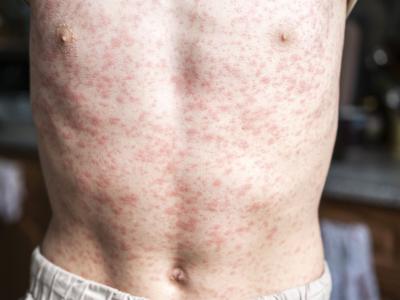Jun 9, 2011 (CIDRAP News) – An epidemiologic report from German investigators yesterday said the initial case-control study found that just 28% of patients reported they had eaten sprouts, the lead suspect in Europe's Escherichia coli outbreak, pointing up a factor can be difficult to interpret in foodborne illness situations.
Though German public officials seem to be zeroing in on sprouts, interviews comparing the food consumption patterns of sick patients and healthy people still suggest that several types of vegetables could be the source, and a third study is under way to focus more on salad ingredients. The full report, posted on the Robert Koch Institute's Web site, appears in German. (CIDRAP News obtained a professionally translated version of the findings.)
The RKI said a trace-back investigation conducted by Lower Saxony state's department of agriculture suggests that E coli patients ate sprouts that came from a specific farm, a development that was announced on Jun 5. It said the country's national laboratory at the Federal Institute for Risk Assessment was still conducting tests on the farm's sprout samples.
Yesterday Lower Saxony officials announced two new clues—more case clusters that pointed to sprouts and the identification of two sick farm employees—that cast stronger suspicion on sprouts, even though officials in neighboring Saxony Anhalt state found the E coli O104:H4 outbreak strain on a piece of cucumber from a sick family's compost bin.
Sprouts-related unknowns
Craig Hedberg, PhD, a foodborne disease expert at the University of Minnesota, said it's difficult to tell if the 28% sprout consumption rate is high compared to German dietary patterns, but it might represent a marked increase. He said the background rate for sprout consumption in the United States typically doesn't exceed 10%.
He said he has seen outbreaks in which implicated foods were consumed by fewer than half of the patients, which he said could happen with a food item like sprouts, since they can appear inconspicuously in salads or sandwiches.
Sprouts can also pose a cross-contamination risk, Hedberg said. "Who hasn't been to a salad bar and seen alfalfa sprouts in many of the neighboring ingredient containers?"
Also, infected workers can contaminate a range of other food items, masking the original contamination source, he said, adding, "In short, there are many reasons why, in a prolonged outbreak associated with sprouts, sprouts may not appear to have been eaten by a high percentage of cases."
Beth Kautz, PhD, director of language instruction in the University of Minnesota's German, Scandinavian, and Dutch department, told CIDRAP News that Germans like making mixed vegetable salads, which can include any of a variety of sprouts but typically do not include iceberg lettuce.
She said many Germans buy their produce at farmer's markets. Besides the traditional German diet, many people eat a very healthful diet, and many opt for organic and vegetarian selections, Kautz added.
Report spells out food safety risks
In related developments, the European Food Safety Authority (EFSA) today released an urgent report on the public health risks of Shiga-toxin producing E coli (STEC) in fresh vegetables.
It said the E coli O104:H4 outbreak strain shares virulence characteristics of both STEC and enteroaggregative E coli (EAEC), with STEC strains typically having an animal reservoir and EAEC strains a human reservoir. It said more detailed genetic assessment will show if it is an EAEC strain that acquired STEC characteristics or the other way around. The agency also said more information on the pathogen's antimicrobial resistance genotype could shed more light on the epidemiology of the outbreak.
STEC outbreaks are increasingly linked to vegetable consumption, especially sprouting seeds and leafy greens, according to the 50-page report. It pointed out that outbreaks can involve more than one exposure route, such as contamination of food by infected workers. "Especially during the late stages of an outbreak multiple exposure routes are likely," the authors wrote.
The EFSA emphasized that food could become contaminated with STEC at many different steps along the production chain.
Case numbers continue to grow
Meanwhile, the number if infections, hemolytic uremic syndrome (HUS) cases, and deaths linked to the outbreak continued to grow, and more countries reported cases. The European Centre for Disease Prevention and Control (ECDC) said today that EU countries have reported 2,142 E coli cases, along with 757 cases of HUS. Twenty-seven deaths have now been connected to the outbreak. The totals reflect 121 more infections, 35 more HUS cases, and 2 more deaths since yesterday.
Switzerland yesterday reported five cases linked to the outbreak, all in patients who had traveled to Germany, according to Agence France-Presse (AFP). So far all the patients are in stable condition and show no signs of complications.
Polish officials said they have confirmed two infections linked to the outbreak so far and are waiting for test results on 18 other patients, Polskie Radio reported. The confirmed cases include one in a man who got sick after traveling to Germany and his 7-year-old son. The father reportedly had a mild infection and his son is in serious but stable condition.
Yesterday Germany's health minister, Daniel Bahr, said the number of new infections seemed to be declining, but the outbreak isn't over. Yesterday's report from the RKI said the earliest onset of diarrhea with and without HUS was May 1, and the most recent onset for both was Jun 4. It said the number of daily reports of diarrhea with HUS peaked at 58 on May 21. The peak for EHEC cases without HUS was May 22 with 128 new cases.
See also:
Jun 9 ECDC outbreak update
Jun 9 ESFA report on STEC risk in fresh vegetables
Jun 8 AFP story
Jun 9 Polskie Radio report


















